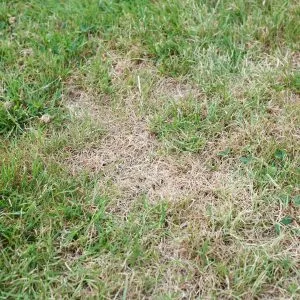Yellow and brown dead patches in your grass are not always signs of lawn disease or drought stress. The damage left behind by the hairy chinch bug (Blissus leucopterus hirtus) looks very similar. Preferring cool season turfs like bentgrass, Kentucky bluegrass, perennial ryegrass, and tall fescue, this bad bug pierces grass blades and sucks out nutrients, eventually killing areas of the lawn. Most damage occurs during the hottest months of summer, especially during dry weather.
Identifying the Chinch Bug
Less than a quarter inch long, the body of an adult chinch bug is black with white markings on the wings. During the nymphal stage (pre-adult) the bugs are smaller, wingless, and have orange or red markings instead. Eggs are oval and whitish with blunt ends.
These insects favor dry, sunny locations. You’ll find them living in the thatch layer of the lawn or at the base of the grass blades. Hairy chinch bugs emit an unpleasant odor when crushed under foot. So that odd smell as you walk through the grass might be bugs.
Signs and Symptoms
Brown or dead patches of grass with yellowing borders indicate possible chinch bug damage. These patches expand and eventually converge. If you think this might be due to dryness, give your lawn a good watering. Damage from these pests won’t green up afterward.
Use the flotation or coffee can method to determine if you have enough chinch bugs in one area to warrant a serious problem. This requires a coffee can, or other container, with the lid and bottom removed. Most feeding activity is found where the yellowing grass border meets the greener lawn. Place the can half into the ground along the yellow border. Fill it almost to the top with water. After five to ten minutes you should see the insects floating on top. Four or more bugs floating indicates a problem. Your lawn can tolerate anything less.
Another method to bring the bugs to the top is to mix water and dish soap and soak a square-foot area of lawn with the solution. If you see 15 or more insects per square foot, it’s time to take action. Test your lawn often throughout the summer months.
Chinch Bug Prevention and Control
If chinch bug populations are unusually high, using chemical controls may be necessary. Insecticides work well on these pests, but it’s important to apply the right chemical at the right time to have success. Make sure to follow directions on the label exactly. Liquid formulas work best because they soak into the soil better. By performing the coffee can test, you can identify locations to apply spot treatments.
Like with most pests, diseases, and weeds, a strong healthy lawn is the best defense against the chinch bug. Healthy lawns tolerate smaller pest populations, and also contain many natural predators to keep the populations in check. Maintain your lawn with regular mowing, fertilizing, and watering, plus reseed bare or thinned areas. Here are some other ways to help prevent this bug from bothering your turf.
- Keep the thatch layer of your lawn to a minimum by aerating.
- Mow the lawn at the appropriate height for the grass type.
- Don’t over fertilize.
- Water your lawn. These pests prefer dryness and don’t do well in wet conditions, including heavy rain.
Need an Expert?
There are many look-alikes that can be mistaken for chinch bugs, like pirate bugs and big-eyed bugs. These insects are harmless. In fact, big-eyed bugs prey on chinch bugs, helping to keep the population down, so you don’t want to get rid of them.
If you’re unsure what’s causing your lawn to look sickly or what kind of pest is responsible for damage, call in an expert. Contact Free Spray Lawn Care today at 419-529-5296 and let us help you keep unwanted pests from destroying your lawn.



Comments (0)
Thanks for your comment!
Thanks for your feedback! Your comments have been successfully submitted! Please note, all comments require admin approval prior to display.
Error submitting comment!
There is a problem with your comment, please see below and try again.